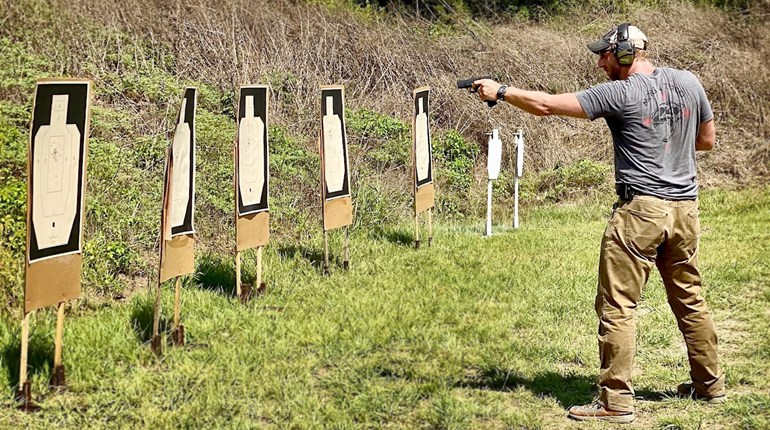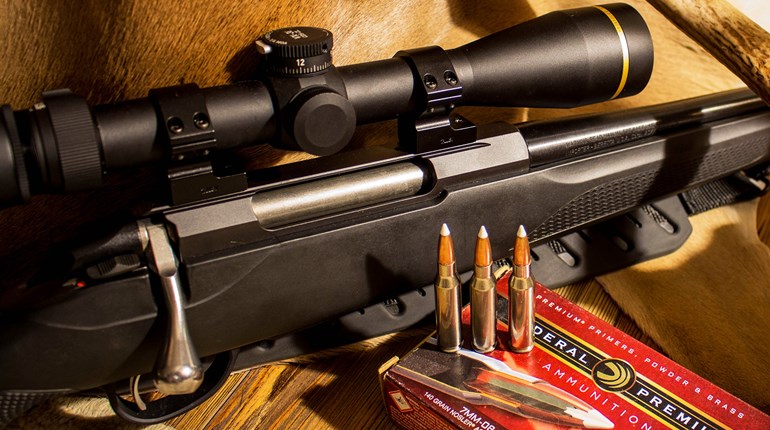
We started talking about the notion of being “a hand down” to encourage consideration of just how many circumstances there may be where your preferred ergonomics just won’t work: There comes a time when Weaver/Isosceles cannot be applied. In fact, it may partly be the reason you’re selected for an assault. From the bad guy’s perspective, you’re encumbered. In the remorseless mindset of the parasite, crook and bully, advantage him.

So for a host of possible reasons, you now must offer armed defense of yourself or others using only one hand. Which, inconveniently, many of us don’t practice, and may not even know how to do.
Many shooters with sound two-handed technique simply drop the weak hand and go to work—feet, hand, arm and head positions otherwise do not change. In most cases, the results are on a par with this less-than-thoughtful approach—mediocre. A magazine/cylinder or two is “enough of that crap!” And therein lies another problem: The better your two-handed technique, the less fun it is to work on something that yields dramatically, even humiliatingly, worse results. Does it help if we say, “Yeah, us too”?
But get it through your head: Having no clear idea how to shoot well with one hand is just laziness, and means your battery of defensive skills is missing a crucial component.
So here we go:
Feet – If your version of “melded” Weaver/Isosceles has the weak side foot slightly forward of the strong side foot (as we’ve recommended), you’ll swap this. The strong side foot is now forward, though weight remains evenly distributed. The goal is to align the recoil axis closer to parallel with the body, rather than perpendicular.
Head – If you think “tactical turtle” is a problem with two hands, it becomes a big problem now. Keep that head as still as possible, and this generally means erect—not tilted, and certainly not canted forward. Bring the sights (and pistol) up to the eyes, not the eyes down to the sights. Bringing the head down has another deficit that is entirely practical, that is, not a mere opinion: Your pistol will move a good deal more in recoil when shooting one-handed, and a head-down position means that recoil movement creates a bigger window of target obscuration. That’s not a good idea (duh) when individual shots may count more than ever, and over a very short period of time.
Weak Hand – Weak hand position depends heavily on circumstance, and we assume it’s “occupied,” holding something or someone. Otherwise, it would (generally) be available for a two-handed grip. If there’s another manipulation going on—like a gesture or reach—make sure that free hand doesn’t get in front of the muzzle. Competition shooters often press the palm or fist against the chest when shooting a one-handed string (and a variety of reasons for doing so are articulated), but this has little application to defensive shooting. It is actually better to have something in the non-shooting hand, as this simulates a more realistic defensive encumbrance—a briefcase, satchel, purse, etc. If the object is heavy enough, it will also have an effect on how you handle recoil and help you learn about good foot placement.

Strong Hand – The most dramatic changes to your established, practiced technique occur with the gun hand—which may be either strong or weak, remember—so you must practice them with both hands.
One of the reasons that simply dropping the weak hand off the pistol doesn’t work very well is obvious: With one point of support and attachment, recoil energy is now applied to the far end of a long, whippy stick—your outstretched arm—and it proceeds to have its ugly/inaccurate way with every press of the trigger. Uh, damn it?
A second issue is more subtle, but crucial to fixing first. Most shooters try to keep the sights vertical. This is not a mistake per se, but it is a relatively profound disadvantage that a simple experiment demonstrates: When you reflexively point your index finger at a distant object, you are extremely unlikely to find that the back of the hand or knuckles are vertical at the end of the motion.
Over a long period, and hence a large sample set, we’ve observed that the most natural motion (not, repeat NOT, mimicking shooting) rolls the hand toward the centerline of the body, and the back of the hand comes to rest angled between 30 and 60 degrees off the vertical. Usually, the third knuckle of the index finger (where it joints the hand) forms the apex of a neat pyramid as you look down your outstretched arm.
The amount of roll certainly varies from person to person and won’t necessarily be the same with both hands (musculature and dexterity are different). But the point is that a semi-conscious verticality bias is overlaid by the presence of a gripped handgun, and tends to suppress this natural cant.
We argue that’s a bad thing. When trying to keep the sights and hand vertical, the wrist rolls outwards in an inherently weak way. As a compensation for that weakness, there’s a tendency to straighten the entire arm. This may seem to help on the front end of the shot (remember the same effect occurs in two-handed technique), but it will sabotage the back end, and for the same reason: It’s a step backward to a skeletal model of recoil absorption, rather than the muscular model of recoil dissipation.
Instead, allow the pistol to cant inward at the natural angle taken by the forearm and wrist. This keeps that weakening twist out of the wrist joint while allowing the elbow to remain bent. Most shooters find this facilitates increased grip and wrist tension with a pervasive benefit we’ve talked about before—keeping energy (and motion) mostly forward of the elbow. In a semi-auto, this can be crucial to keeping your pistol from malfunctioning.

By the way, we know this has an absurdly Hollywood-esque appearance, but know of nothing else that produces the same good results.
Assuming the natural cant with a bent elbow brings two other advantages into play for the one-handed shot. The straight arm, in addition to its other deficiencies, requires more energy to maintain keep-the-gun-running tension, so most shooters find they tire more quickly. Even more important is the tendency of the stiff arm to bounce in movement: Remember, your first goal is to get off an attacker’s “X.” When that’s done, a rigid, flailing gun arm won’t help you do what may have to come after that.
The second advantage tends to be subjective, though we think it’s a big one—thumb position. Here, we encouraged you to point that shooting-hand thumb forward as a neuromuscular aid to aiming as well as a wrist stiffener that doesn’t compromise the third “P” (trigger press). In one-handed shooting, we suggest that there is a better deployment of that thumb: arch it up to create tension under the backstrap of an auto-loader. This replaces some of the lost first “P” pressure normally applied by the weak hand. The thumb continues to point forward on a revo as there’s no structure that allows the up-thumb position to leverage as it can on an auto-loader.
One common objection to embracing the cant is sight position/alignment. For the most part, however, a careful mental trip through the geometry reveals that very little will change at defensive distances. Allowing the gun to roll only moves the aim point very slightly right (from the left hand) or left (from the right hand), and ballistic arc, of course, will remain identical. If you find a lot of apparent variation in your early practice, don’t worry: These will disappear as your one-handed trigger press “matures.” Beyond a wholesome discipline, don’t be too hard on yourself, but do keep at it.
Now Carry on.


































